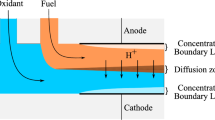Abstract
Diffusion boundary layer on the electrode surface of microfluidic fuel cells limits the mass transfer to the catalyst layer. Thus, investigation of the transient response of microfluidic fuel cell associated with the change in operating condition is not a trivial work. In this paper, transient characteristics of a microfluidic fuel cell upon changes in voltage load is investigated by applying a transient three-dimensional, two-phase and non-isothermal numerical model. Proposed model is developed with COMSOL multi-physics and governing equations are formulated based on the conservation laws for mass, momentum, species and electrical potentials. This model evaluates the effect of a dominant dynamic aspect of MFFC operation (mass transfer effect), accounts for transient convective and diffusive transport, and allows prediction of species concentration. Simulation results show that during step voltage change, the transient current lags behind voltage due to the time constant of reactant species transport. Also, simulation results show that the over/under shot of the current density occurs during the step change in the fuel cell voltage. The limited mass transport in the diffusion boundary layer causes a time delay between the voltage step change and the change of reactant distribution on the electrode surface. During the step voltage decrease/increase, the initial higher/lower reactant concentration on the electrode surface causes the over/under-shoot of current density. Simulation results show that the properties of the current over/undershoot can be varied according to the different values of functional parameters of the fuel cell.








Similar content being viewed by others
REFERENCES
Hahn, R., Wagner, S., Schmitz, A., and Reichl, H., Development of micro fuel cells with organic substrates and electronics manufacturing technologies, J. Power Sources, 2004, vol. 131, p. 73.
McLean, G.F., Djilali, N., Whale, M., and Niet, T., Application of micro-scale techniques to fuel cell systems design, Proc. 10th Canadian Hydrogen Conf., Quebec City, 2000, p. 349.
Chang, M.H., Chen, F., and Fang, N.S., Analysis of membraneless fuel cell using laminar flow in a Y‑shaped microchannel, J. Power Sources, 2006, vol. 159, p. 810.
Chen, F., Chang, M.H., and Lin, M.K., Analysis of membraneless formic acid microfuel cell using a planar microchannel, Electrochim. Acta, 2007, vol. 52, p. 2506.
Ebrahimi Khabbazi, A., Richards, A.J., and Hoorfar, M., Numerical study of the effect of the channel and electrode geometry on the performance of microfluidic fuel cells, J. Power Sources, 2010, vol. 195, p. 8141.
Feali, M.S. and Fathipour, M., Multi-objective optimization of microfluidic fuel cell, Russ. J. Electrochem., 2014, vol. 50, p. 561.
Herlambang, Y.D., Shyu, J.C., and Lee, S.C., Numerical simulation of the performance of air-breathing direct formic acid microfluidic fuel cells, Micro Nano Lett., 2017, vol. 12, p. 860.
Hollinger, A.S., Doleiden, D.G., Willis, M.G., DeLaney, S.C., Burbules, M.B., Miller, K.L., and Argun, N., Model-based analysis of thermal and geometrical effects in a microscale methanol fuel cell, Int. J. Hydrogen Energy, 2018, vol. 43, p. 5145.
Moein-Jahromi, M., Movahed, S., and Kermani, M.J., Numerical study of the cathode electrode in the Microfluidic Fuel Cell using agglomerate model, J. Power Sources, 2015, vol. 277, p. 180.
Sundmacher, K., Schultz, T., Zhou, S., Scott, K., Ginkel, M., and Gilles, E., Dynamics of the direct methanol fuel cell (DMFC): experiments and model-based analysis, Chem. Eng. Sci., 2001, vol. 56, p. 333.
Ceraolo, M., Miulli, C., and Pozio, A., Modelling static and dynamic behaviour of proton exchange membrane fuel cells on the basis of electro-chemical description, J. Power Sources, 2003, vol. 113, p. 131.
Li, H.Y., Weng, W.C., Yan, W.M., and Wang, X.D., Transient characteristics of proton exchange membrane fuel cells with different flow field designs, J. Power Sources, 2010, vol. 196, p. 235.
Yan, W.M., Li, H.Y., and Weng, W.C., Transient mass transport and cell performance of a PEM fuel cell, Int. J. Heat Mass Transf., 2017, vol. 107, p. 646.
Amiri, S., Hayes, R.E., and Sarkar, P., Transient simulation of a tubular micro-solid oxide fuel cell, J. Power Sources, 2018, vol. 407, p. 63.
Meng, H., Numerical investigation of transient responses of a PEM fuel cell using a two-phase non-isothermal mixed-domain model, J. Power Sources, 2007, vol. 171, p. 738.
Nguyen, N.T. and Wereley, S.T., Fundamentals and Applications of Microfluidics, 2nd ed., Boston: Artech House, 2006.
Bard, J. and Faulkner, L.R., Electrochemical Methods: Fundamentals and Applications, New York: John Wiley Sons, 2000.
Bonnefont, A., Argoul, F., and Bazant, M.Z., Analysis of diffuse-layer effects on time-dependent interfacial kinetics, J. Electroanal. Chem., 2001, vol. 1–2, p. 52.
Spraguel, I.B. and Dutta, P., Modeling of diffuse charge effects in a microfluidic based laminar flow fuel cell, Num. Heat Transf., 2011, vol. 59, p. 1.
Ong, I.J., Double-layer capacitance in a dual lithium ion insertion cell, J. Newman Electrochem. Soc., 1999, vol. 146, p. 4360.
Spiegel, C., Modeling and Simulation Using MATLAB, New York: Acad. Press, 2008.
Probstein, R.F., Physicochemical Hydrodynamics: an Introduction, 2nd ed., New York: John Wiley&Sons, 2003.
Bird, R.B., Stewart, W.E., and Lightfoot, E.N., Transport Phenomena, 2nd ed., New York: John Wiley&Sons, 2002.
Choban, E.R., Markoski, L.J., Wieckowski, A., and Kenis, P.J.A., Microfluidic fuel cell based on laminar flow, J. Power Sources, 2004, vol. 128, p. 54.
Author information
Authors and Affiliations
Corresponding author
Ethics declarations
The authors declare that they have no conflict of interest.
Rights and permissions
About this article
Cite this article
Feali, M.S. Transient Response of Microfluidic Fuel Cell. Russ J Electrochem 56, 437–446 (2020). https://doi.org/10.1134/S1023193520030040
Received:
Revised:
Accepted:
Published:
Issue Date:
DOI: https://doi.org/10.1134/S1023193520030040




